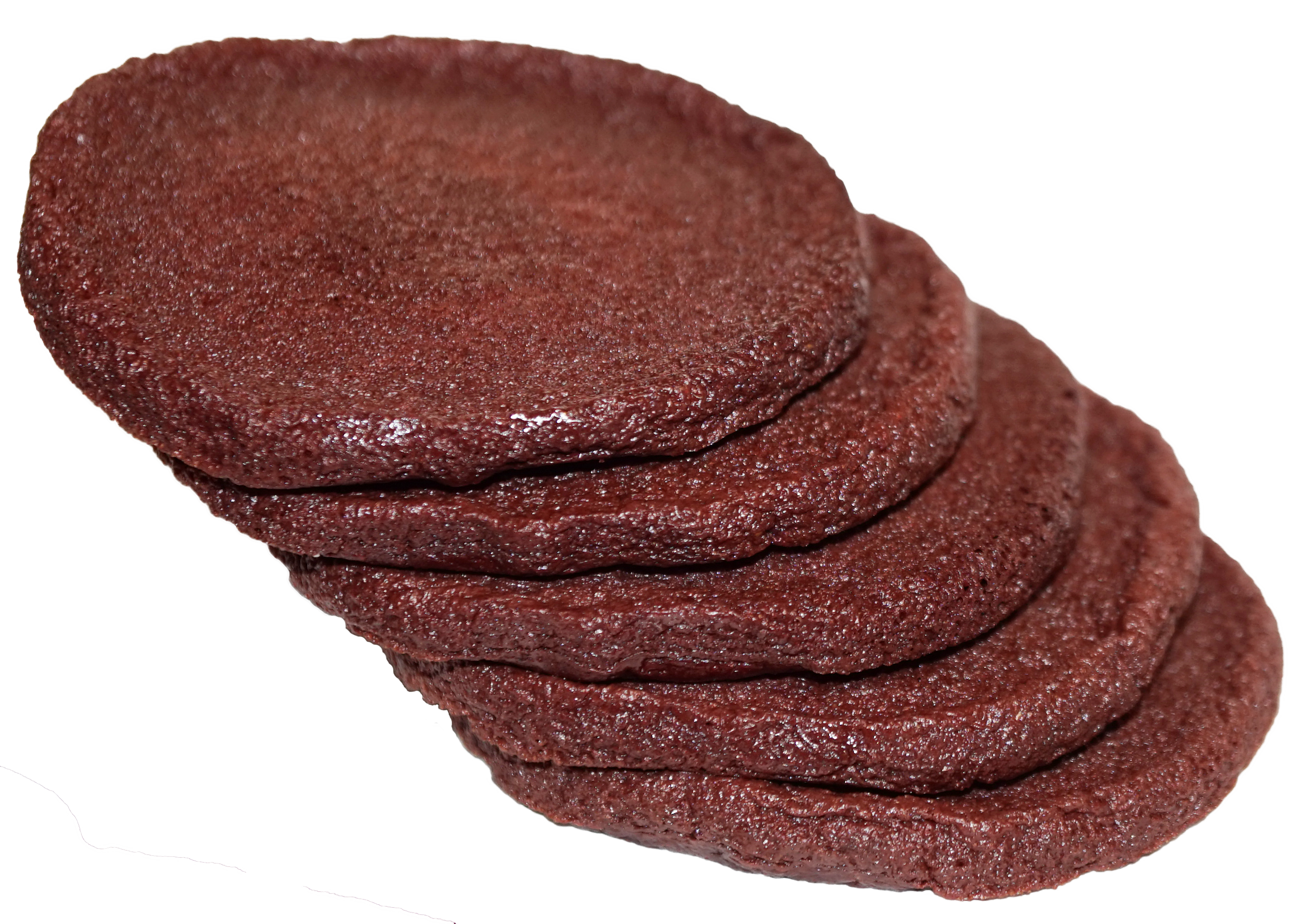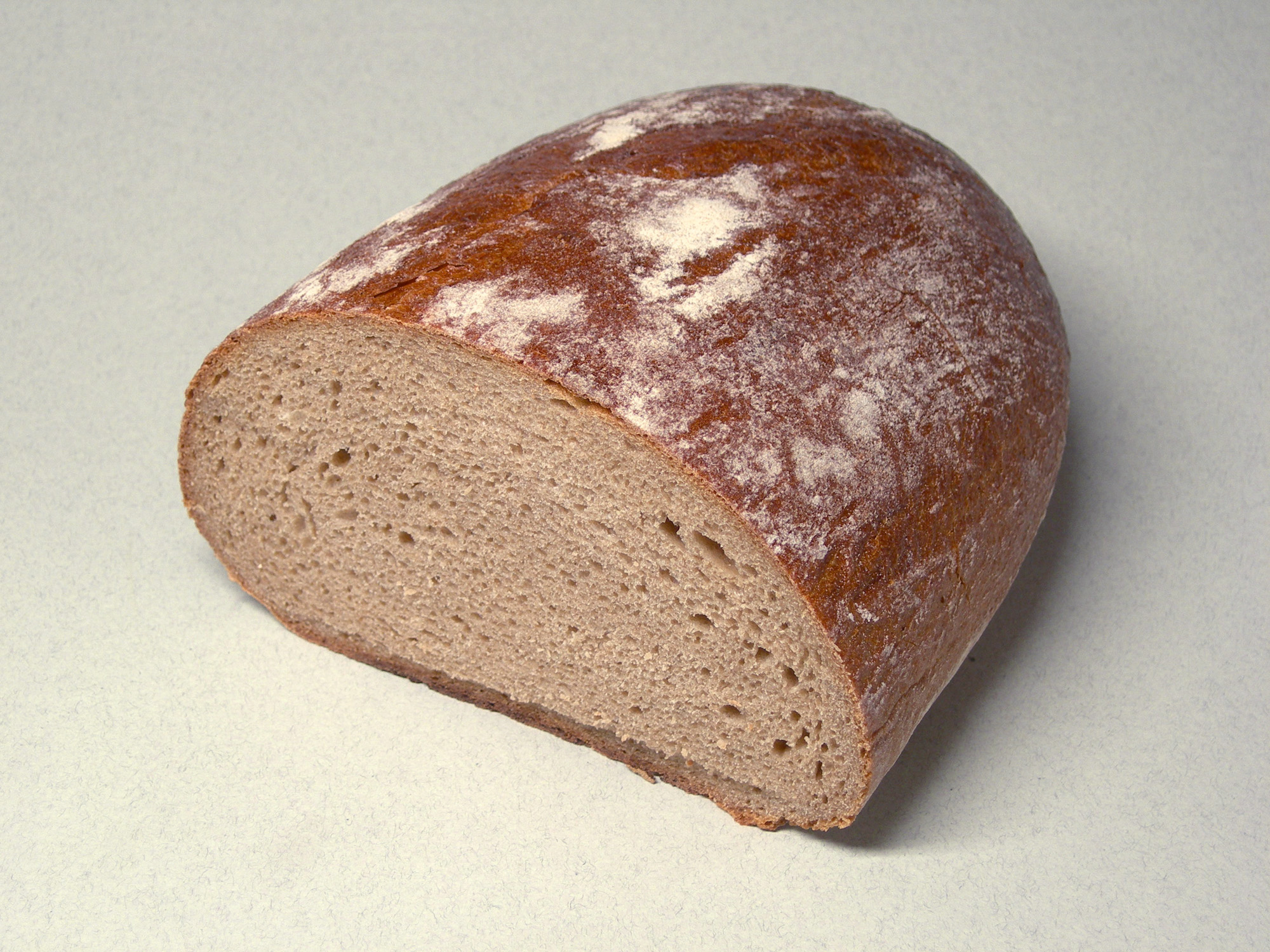|
Blodplättar
Blodplättar (in Swedish; blodpannekaker in Norwegian, veriohukainen, verilätty or verilettu in Finnish; verikäkk in Estonian), or blood pancakes in English are a dish served in Finland, Estonia, Sweden and Norway made of whipped blood (typically reindeer blood), water or pilsner, flour and eggs. It is similar to black pudding, but is thinner and crispier. Blodplättar may be fried in a frying pan. The pancakes are usually served with crushed lingonberries or lingonberry jam, sometimes with pork or reindeer meat. In Swedish, the word may also be used to refer to blood platelets Platelets or thrombocytes () are a part of blood whose function (along with the coagulation factors) is to react to bleeding from blood vessel injury by clumping to form a blood clot. Platelets have no cell nucleus; they are fragments of cyto .... Blodplättar tastes very similar to black pudding and has a bone marrow flavor. See also * Blodpalt References External links Picture of Finnish ' ... [...More Info...] [...Related Items...] OR: [Wikipedia] [Google] [Baidu] |
Swedish Language
Swedish ( ) is a North Germanic languages, North Germanic language from the Indo-European languages, Indo-European language family, spoken predominantly in Sweden and parts of Finland. It has at least 10 million native speakers, making it the Germanic_languages#Statistics, fourth most spoken Germanic language, and the first among its type in the Nordic countries overall. Swedish, like the other North Germanic languages, Nordic languages, is a descendant of Old Norse, the common language of the Germanic peoples living in Scandinavia during the Viking Age. It is largely mutually intelligible with Norwegian language, Norwegian and Danish language, Danish, although the degree of mutual intelligibility is dependent on the dialect and accent of the speaker. Standard Swedish, spoken by most Swedes, is the national language that evolved from the Central Swedish dialects in the 19th century, and was well established by the beginning of the 20th century. While distinct regional Variety ( ... [...More Info...] [...Related Items...] OR: [Wikipedia] [Google] [Baidu] |
Swedish Cuisine
Swedish cuisine () is the traditional food of Sweden. Due to Sweden's large north-to-south expanse, there are regional differences between the cuisine of Norrland, North and South Sweden. Historically, in the far north, meats such as reindeer, and other Game (hunting), game dishes were eaten, some of which have their roots in the Sámi people#Sámi culture, Sami culture, while fresh vegetables have played a larger role in the South. Many traditional dishes employ simple, contrasting flavours, such as the traditional dish of meatballs and brown cream sauce with tart, pungent lingonberry jam. General features Swedish cuisine could be described as centered around cultured dairy products, crisp and soft breads, berries and stone fruits, beef, Chicken (food), chicken, Lamb and mutton, lamb, pork, eggs, and seafood. Potatoes are often served as a side dish, often boiled. Swedish cuisine has a wide variety of breads of different shapes and sizes, made of rye, wheat, oat, white, dark ... [...More Info...] [...Related Items...] OR: [Wikipedia] [Google] [Baidu] |
Norwegian Cuisine
Norwegian, Norwayan, or Norsk may refer to: *Something of, from, or related to Norway, a country in northwestern Europe *Norwegians, both a nation and an ethnic group native to Norway * Demographics of Norway *Norwegian language, including the two official written forms: ** Bokmål, literally "book language", used by 85–90% of the population of Norway **Nynorsk, literally "New Norwegian", used by 10–15% of the population of Norway * Norwegian Sea Norwegian or may also refer to: Norwegian * Norwegian Air Shuttle, an airline, trading as Norwegian ** Norwegian Long Haul, a defunct subsidiary of Norwegian Air Shuttle, flying long-haul flights * Norwegian Air Lines, a former airline, merged with Scandinavian Airlines in 1951 * Norwegian coupling, used for narrow-gauge railways *Norwegian Cruise Line, a cruise line * Norwegian Elkhound, a canine breed. * Norwegian Forest cat, a domestic feline breed *Norwegian Red, a breed of dairy cattle *Norwegian Township, Pennsylvania, USA ... [...More Info...] [...Related Items...] OR: [Wikipedia] [Google] [Baidu] |
Finnish Cuisine
Finnish cuisine is notable for generally combining traditional country fare and ''haute cuisine'' with contemporary continental-style cooking. Fish (food), Fish and meat (usually pork, beef or reindeer) play a prominent role in traditional Finland, Finnish dishes in some parts of the country, while the dishes elsewhere have traditionally included various vegetables and Edible mushroom, mushrooms. Evacuation of Finnish Karelia, Evacuees from Karelia contributed to foods in other parts of Finland in the aftermath of the Continuation War. Finnish foods often use wholemeal products (rye, barley, oats) and berries (such as bilberry, bilberries, lingonberry, lingonberries, cloudberry, cloudberries, and sea buckthorn). Milk and its derivatives like buttermilk are commonly used as food, drink or in various recipes. Various turnips were common in traditional cooking, but were replaced with the potato after its introduction in the 18th century. Characteristics The way of life and cultu ... [...More Info...] [...Related Items...] OR: [Wikipedia] [Google] [Baidu] |
Estonian Cuisine
Traditional Estonian cuisine has substantially been based on meat and potatoes, and on Fish (food), fish in coastal and lakeside areas. However, it now shows influences from a variety of international cuisines and ingredients, with a number of contributions from the traditions of nearby countries. German cuisine, German, Swedish cuisine, Swedish, Russian cuisine, Russian, Finnish cuisine, Finnish and other influences have played their part. The most typical foods in Estonia have been rye bread, barley, pork, fish, potatoes and dairy cattle, cow dairy products. In terms of staple food, Estonia is similar to other countries in the Baltic Sea Baltic region, region. Cold table The Entrée, first course in traditional Estonian cuisine is based on cold dishes — a selection of pickling, pickles, meats and sausages () served with potato salad (), cottage cheese (''kodujuust''), or ''rosolje'', an Estonian signature dish almost identical to Swedish , based on beetroot, potatoes and herr ... [...More Info...] [...Related Items...] OR: [Wikipedia] [Google] [Baidu] |
Blodpalt
Blodpalt (in Swedish) or ( ) is an old-fashioned dish still fairly common in northern Finland and parts of northern Sweden. The dish's history goes back to a time when the households carefully made use of all parts of the animals to get enough food. ''Blodpalt'' is essentially ''palt'', a dumpling made from barley or rye flour and (but not always) grated raw potatoes, with blood added to the dough, which makes it a more nutritious meal that was often eaten during the dark and long winter. In Lapland, ''blodpalt'' is usually made with reindeer blood, and rye or wheat flour, but no potatoes, and served either as dumplings in a soup, or with unsmoked bacon. In other parts of northern Sweden, ''blodpalt'' is made the same way as regular bacon-filled ''palt'', but with blood added to the dough. See also *Black pudding Black pudding is a distinct national type of blood sausage originating in the United Kingdom and Ireland. It is made from pork or occasionally beef Blood as foo ... [...More Info...] [...Related Items...] OR: [Wikipedia] [Google] [Baidu] |
Platelets
Platelets or thrombocytes () are a part of blood whose function (along with the coagulation factors) is to react to bleeding from blood vessel injury by clumping to form a blood clot. Platelets have no cell nucleus; they are fragments of cytoplasm from megakaryocytes which reside in bone marrow or lung tissue, and then enter the circulation. Platelets are found only in mammals, whereas in other vertebrates (e.g. birds, amphibians), thrombocytes circulate as intact mononuclear cells. One major function of platelets is to contribute to hemostasis: the process of stopping bleeding at the site where the lining of vessels (endothelium) has been interrupted. Platelets gather at the site and, unless the interruption is physically too large, they plug the hole. First, platelets attach to substances outside the interrupted endothelium: ''adhesion''. Second, they change shape, turn on receptors and secrete chemical messengers: ''activation''. Third, they connect to each other throu ... [...More Info...] [...Related Items...] OR: [Wikipedia] [Google] [Baidu] |
Reindeer
The reindeer or caribou (''Rangifer tarandus'') is a species of deer with circumpolar distribution, native to Arctic, subarctic, tundra, taiga, boreal, and mountainous regions of Northern Europe, Siberia, and North America. It is the only representative of the genus ''Rangifer''. More recent studies suggest the splitting of reindeer and caribou into six distinct species over their range. Reindeer occur in both Animal migration, migratory and wiktionary:sedentary#Adjective, sedentary populations, and their herd sizes vary greatly in different regions. The tundra subspecies are adapted for extreme cold, and some are adapted for long-distance migration. Reindeer vary greatly in size and color from the smallest, the Svalbard reindeer (''R.'' (''t.'') ''platyrhynchus''), to the largest, Osborn's caribou (''R. t. osborni''). Although reindeer are quite numerous, some species and subspecies are in decline and considered Vulnerable species, vulnerable. They are unique among deer (Ce ... [...More Info...] [...Related Items...] OR: [Wikipedia] [Google] [Baidu] |
Finland
Finland, officially the Republic of Finland, is a Nordic country in Northern Europe. It borders Sweden to the northwest, Norway to the north, and Russia to the east, with the Gulf of Bothnia to the west and the Gulf of Finland to the south, opposite Estonia. Finland has a population of 5.6 million. Its capital and largest city is Helsinki. The majority of the population are Finns, ethnic Finns. The official languages are Finnish language, Finnish and Swedish language, Swedish; 84.1 percent of the population speak the first as their mother tongue and 5.1 percent the latter. Finland's climate varies from humid continental climate, humid continental in the south to boreal climate, boreal in the north. The land cover is predominantly boreal forest biome, with List of lakes of Finland, more than 180,000 recorded lakes. Finland was first settled around 9000 BC after the Last Glacial Period, last Ice Age. During the Stone Age, various cultures emerged, distinguished by differen ... [...More Info...] [...Related Items...] OR: [Wikipedia] [Google] [Baidu] |
Vaccinium Vitis-idaea
''Vaccinium vitis-idaea'' is a small evergreen shrub in the heath family, Ericaceae. It is known colloquially as the lingonberry, partridgeberry, foxberry, mountain cranberry, or cowberry. It is native to boreal forest and Arctic tundra throughout the Northern Hemisphere. Commercially cultivated in the United States Pacific Northwest and the Netherlands, the edible berries are also picked in the wild and used in various dishes, especially in Nordic cuisine. Description ''Vaccinium vitis-idaea'' spreads by underground stems to form dense clonal colonies. Slender and brittle roots grow from the underground stems. The stems are rounded in cross-section and grow from in height. Leaves grow alternately and are oval, long, with a slightly wavy margin, and sometimes with a notched tip. The flowers are bell-shaped, white to pale pink, long. ''V. vitis-idaea'' begins to produce flowers from five to ten years of age. They are pollinated by multiple insect species, including '' ... [...More Info...] [...Related Items...] OR: [Wikipedia] [Google] [Baidu] |
Frying Pan
A frying pan, frypan, or skillet is a flat-bottomed pan used for frying, searing, and browning foods. It typically ranges from in diameter with relatively low sides that flare outwards, a long handle, and no lid. Larger pans may have a small grab handle opposite the main handle. A pan of similar dimensions, but with less flared, more vertical sides and often with a lid, is called a sauté pan. While a sauté pan can be used as a frying pan, it is designed for lower-heat cooking. History Copper frying pans were used in ancient Mesopotamia. Frying pans were also known in ancient Greece, where they were called () and teganon (τήγανον) and Rome, where they were called ''patella'' or ''sartago''. The word ''pan'' derives from the Old English . Before the introduction of the kitchen stove in the mid-19th century, a commonly used cast-iron cooking pan called a 'spider' had a handle and three legs used to stand up in the coals and ashes of the fire. Cooking pots and pan ... [...More Info...] [...Related Items...] OR: [Wikipedia] [Google] [Baidu] |






